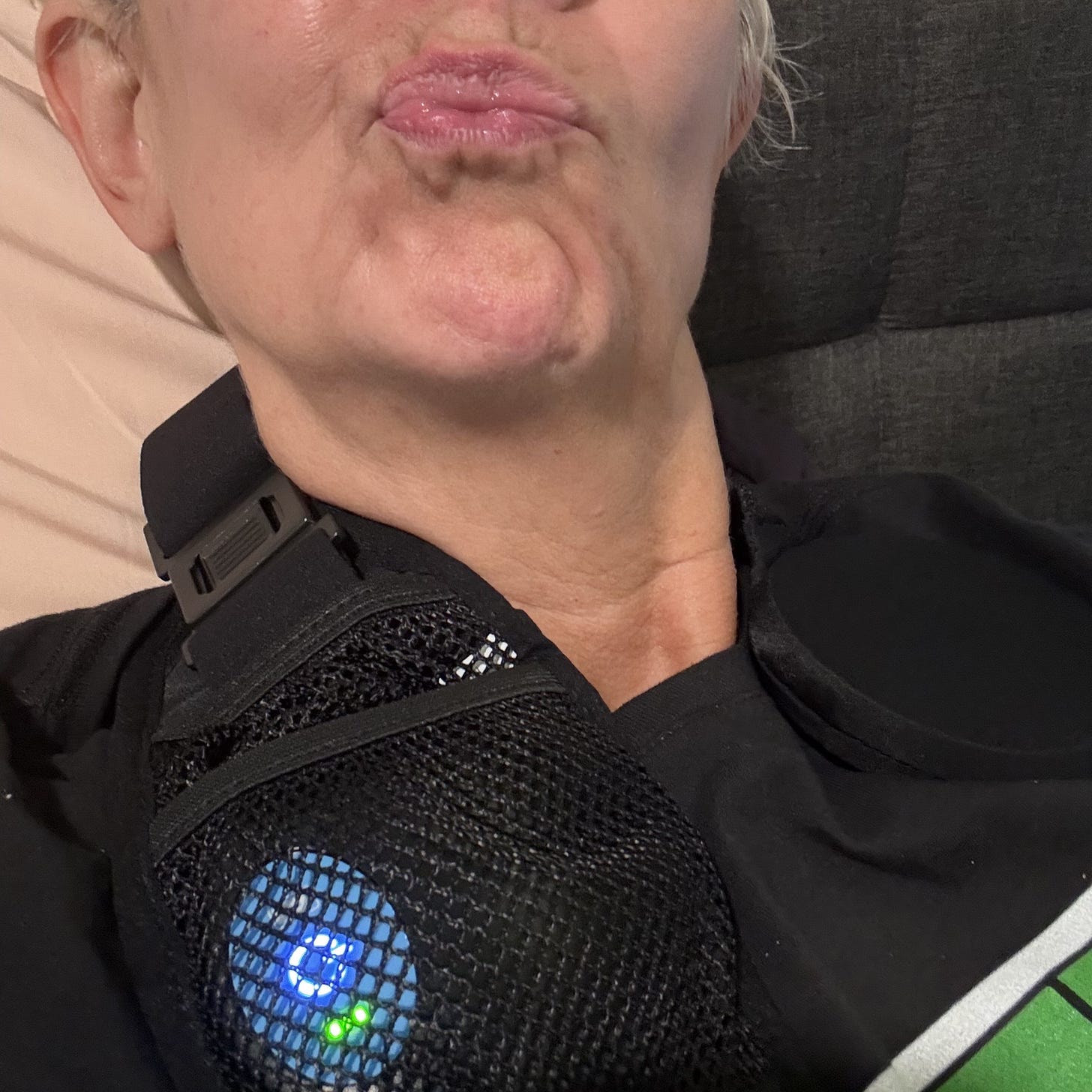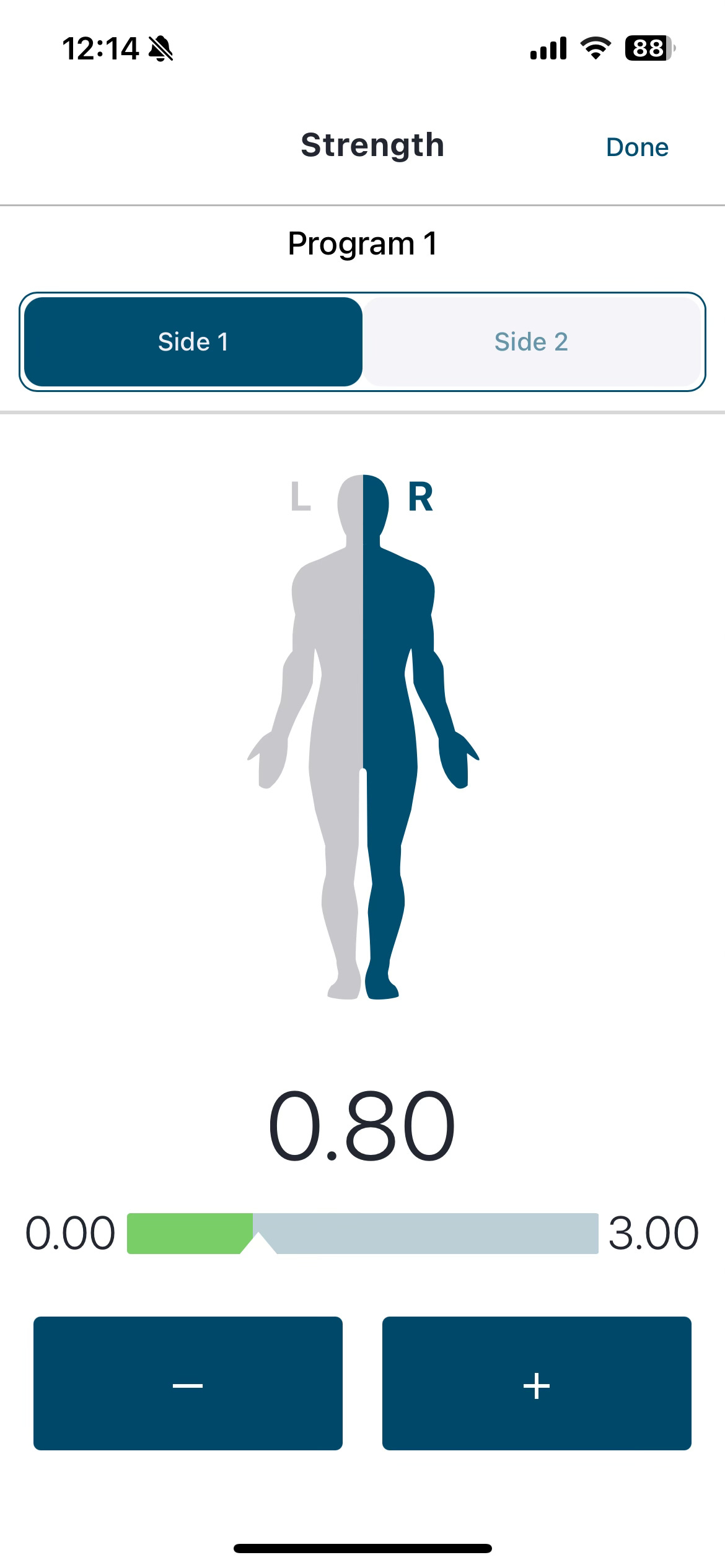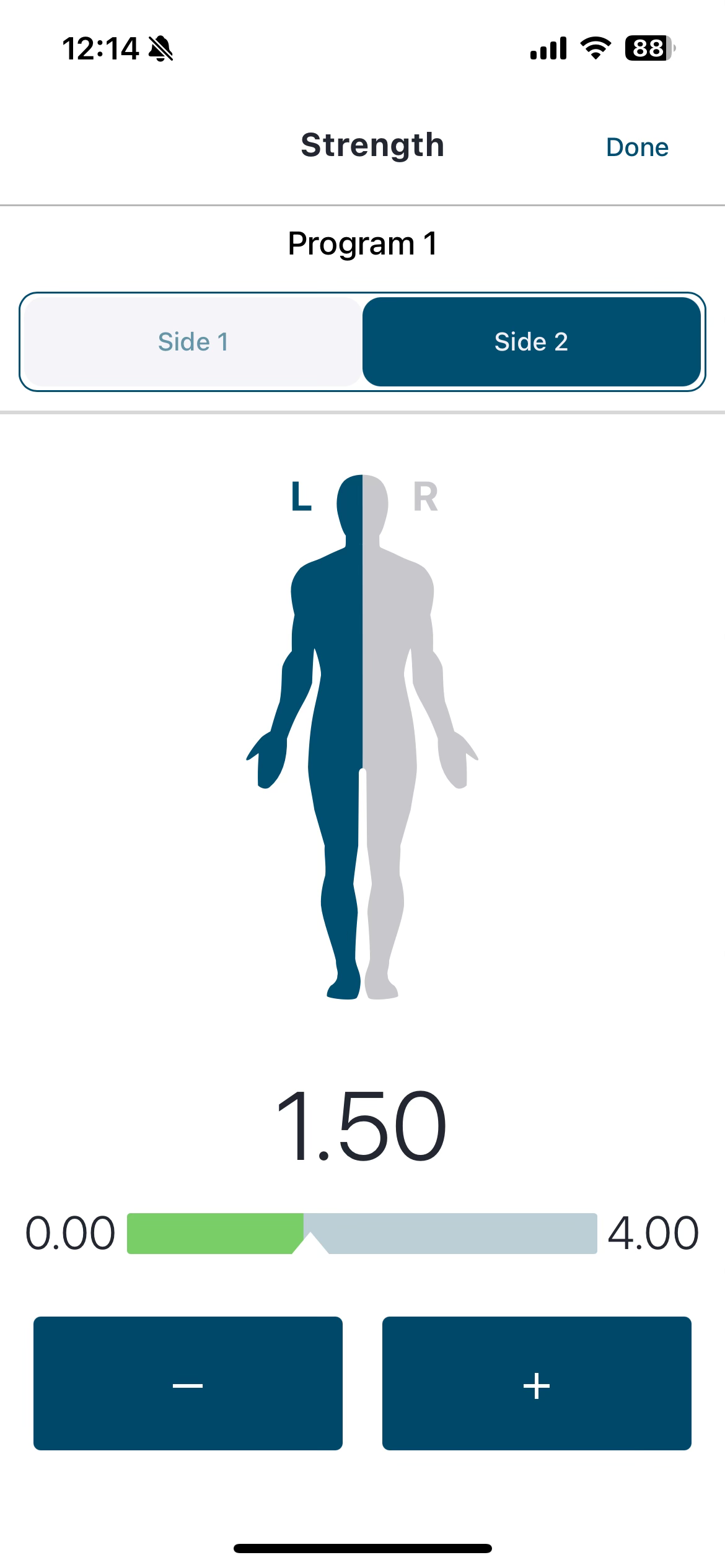Step Three: Let's Do This Thing
All the hardware is in place, welcome to part one of GO TIME
Thank you for your enthusiastic response to my profanity blow out fest post of last week. After a thousand stop and reset moments, I finally made it to the quasi-finish line. I knew from reading about DBS that the programming takes a few months to fine tune, that it isn’t an instant fix for all things Parkinson’s related.
DBS can be extremely effective on those who have tremor as their main symptom. Videos like these are nothing short of scientific magic.
As my main symptoms are dystonia in my feet (painful inverting and cramping) and bradykinesia (overall slowness of movement), my programming results were not going to be so dramatically video worthy.
The day before I had some folks check in to see if I was excited. Honestly, I don’t think I had the energy to be excited, but I was ready to start to see something. Anything that felt like this last year of planning and appointments and surgeries and sitting around was going to add up to anything. Show me what you got, goddess of celebral activity. Give me something to believe in.
I woke up early and immediately became super anxious about the commute to the hospital. Anxious to the point of pacing around clock watching. Keeping in mind I was on ZERO meds, pacing around was not a good use of my waning physical abilities. Usually on zero meds I am able to squeak out a quick trip to the bathroom before both my feet cave in, but on that morning I woke up, took a shower, got dressed and began to worry about traffic. There can be a “honeymoon period” after they implant the electrodes where you get positive results even though nothing is hooked up yet just from the active nature of healing and the brain matter getting accustomed to the hardware. I’m not sure if it was from that or perhaps my extended release meds from the night before were especially extended, but I was able to walk to the car. I had to stop and sit for a moment, but I made it on my own steam to the car, which seemed like an auspicious start.
The roomies and I ended up arriving early, of course. I took the wheelchair chariot into the appointment to avoid a swan dive into the hospital carpet in case my honeymoon period decided without notice that was unceremoniously over.
The programming was scheduled to be done by the neurology department’s nurse practitioner, Carolyn. I like Carolyn a lot, I refer to her as a real straight shooter. Early in my PD experience, I started feeling like I was sinking into a pretty solid depressive episode. Seemed appropriate based on the news. When it lingered past what I thought was an acceptable period of time (aka when the number of carbs you consume is rivaled by the number of Netflix murder shows you watch in a day and that number is NOT PRETTY) I checked in with Carolyn and asked how long people are usually depressed after getting diagnosed. She suggested I might want to try some anti-depressant meds as a way to feel better. No, no, I told her I have taken those before and I now prefer to manage depression through diet and exercise. Carolyn countered with “Depression is a biochemical symptom of Parkinson’s disease. You can eat all the quinoa and do all the yoga you want, but your brain is chemically different now.” I opted for the anti-depressant meds and they helped. I appreciated that she didn’t sugarcoat her advice while also stressing that my situation wasn’t a character defect or a psychological fail. She’s cool like that.
Carolyn and Josh, a department resident, came into the appointment with positive energy. The roomies also joined me for moral support and programming education. She looked at me and explained briefly how the programming would work. She added, “And you’re a real straight shooter, so I’m guessing this will go along fairly quickly.”
You know what they say, if you spot it, you got it.
As they only had my foot dystonia and bradykinesia to program off of, it was going to be a bit challenging to quantify the results. The programming involves stimulating the electrodes, which are broken up into four quadrants as far as the testing. Number one is the deepest in the brain, two the next highest, and so on. They can also stimulate different areas within the quadrants to get different results. It’s a lot like the eye doctor’s “better like this, or better like this” kind of a process.
Carolyn explained that she would start at the number one spot on the right side as I am more affected with PD on the right side on paper (based on my initial diagnosis I am Right Hand dominant PD patient, but things shift and devolve on their own schedule) She bumped up the stimulation just a smidge and then performed a series of tests for rigidity, cognitive function, and speed and quality of movement. Josh would manually rotate my legs and ankles in circles to test the rigidity, I would close my eyes and repeat the months of the year backwards to test my thinking ability. Sometimes this was effortless, sometimes it was a struggle; my roomies reported they could see my eyeballs racing back and forth under my eyelids when things were more difficult.
We would start every series of tests by looking at my feet, which were definitely in a twist upon arrival on zero meds. After multiple rounds of this, I became a bit self conscious of five people staring at my feet. Made sense as dystonia is my most profound and troubling symptom, but I began to wish I had tremor to make this a more satisfying spectator sport.
I would do various hand tests with every bump of electro-magic juice to see if the stimulation improved my bradykinesia as well as taking note of any degradation of my form in doing the finger taps and opening and closing of my hands. They can tell a lot from the speed and ability to perform these exercises with good form over and over.
Most anyone with PD will agree that they will probably be doing these exercises in the afterlife, as they have done these moves at least a million times in this life. TAP TAP TAP.
They would repeat those tests for every bump up of electrical stimulation for each quadrant and sub-quadrant, marking down the benefit, asking every time, “How do you feel?” Mostly I answered “OK” until the stimulation either made me feel weird, lightheaded, or slightly disoriented, then they would stop. Or sometimes they would stop when my right leg started doing a little choreography to music of its own making. Dykinesia (involuntary pointless movements) indicates too much stimulation. They would note what my reaction was at the top level of stimulation and move on to the next level. More bumping up, more rotating of my legs, more eyes closed months of the year in reverse, more open/closed hands, more foot staring. It took 75 minutes to complete the programming, not bad considering the appointment was blocked for two hours. I do shoot straight, even when I’m jiggly.
Carolyn told me to stick around the general vicinity of the hospital for an hour or so in case I had a weird reaction and said we would meet again in a month for fine tuning.
Enter Angelo, Abbott Labs rep (maker of my bionic hardware) to go over the app that controls the generator. We had met Angelo when I had the generator surgically implanted a few weeks back. Angelo is friendly and engaging but not in a cheesy sales person way. My insincerity detector is set to NOPE so I don’t waste precious time with people on the streets with clipboards telling me they love my sense of style and do I have a moment to…NOPE HAVE A BLESSED DAY THANK YOU BYE. Angelo went to medical school, then opted to get into medical technology (I enjoy a LinkedIn snoop on occasion) so Angelo is no dummy. It doesn’t hurt that Angelo is an attractive lad as well. I’ll get off this subject as I don’t have a picture to back this up, sorry kids.
McDreamy Med Tech man fired up the app that he installed on my phone at our first meeting. After connecting to my implanted generator via bluetooth, the screen looks this:
He then clicked on the different sides (right is featured first as I am officially classified as Right Side dominant as far as PD, even though the stimulation is less on that side, again all things subject to change)
Then we looked at the left side. The numbers indicate the stimulation currency being used determined by the testing, with the range on the bottom indicating the level where I showed too much stimulation (3 on the right side, 4 on the left) so my personal tinkering of it couldn’t put me in the danger zone. Cool, amirite?
Then he talked about charging the device. A full charge gives you 37 days of brain zapping capability, pretty generous. The tech on the charger is impressive, there is a puck that you wear around your neck that a third grader could operate (I say this acknowledging that an average third grader probably has better tech skills than I do, but I still have never met a tv remote that I couldn’t make my bitch in less than five minutes)
The puck is in a wearable mesh sleeve that you place around your neck. The non-puck side is weighted so it can stay balanced as you sit with it. The puck makes a lot of beepity beep sounds when you turn it on, then when you place it correctly on the generator, it makes happy beeps and you can see it on the app, like so.
If it gets jostled off the generator, it makes mad beeping sounds, like HEY DOPE YOU ARE NO LONGER CHARGING, GET IT TOGETHER. And the app says something like that as well, but not quite as all caps abusive. A full charge of the generator from completely dead takes about an hour and you charge the charger with a regular USB-C adapter, like an iPhone charger. The puck contains two full charges when it’s topped off.
Me, sporting the new gizmo, getting my generator juiced.

Then we were sent on our way to wander off the rest of the hour that we were advised to stay in the vicinity.
We decided to take this “proof of life” shot outside on Michigan Avenue near their charming floral display as opposed to in hospital. It seemed more fitting for the occasion.
We toodled around for a bit but all that finger tapping and brain zapping really made me tired on so many levels. Plus the Magnificent Mile in July, talk about American Girl Doll bag schlepping deep dish pizza powered tourist overload. Enough brain shenanigans for today, let’s beat it.
On our walk back to the car, I saw Dr. Hsieh on the street, heading to work. I hadn’t seen him in anything but scrubs since our first meeting. He was looking dapper in a plaid button down and a light tweed jacket. As soon as I saw him coming our way, I yelled “DOCTOR HSIEH!!!”, which was one hundred percent not something I would usually do. He smiled and stopped to chat about the programming and our next visit and how encouraged he was by how things went. I took our chance meeting as a very positive sign. I’m not usually a “IT’S A SIGN!” type of person, but lately I’m getting into it. What can I say, new brain, new game.
This a two part series as this is already quite long and information packed. STAY TUNED for our next episode because there are some hilarious moments in the continuing saga of going electric.










Favorite lines in this piece:
1. You know what they say, if you spot it, you got it.
2. I do shoot straight even when I’m jiggly.
3. I say this acknowledging that an average third grader probably has better tech skills than I do, but I still have never met a TV remote that I couldn’t make my bitch in less than five minutes.
I love the duck face, the fully charged battery t-shirt, and of course, the Love Thug button, of which I am a proud owner and wearer.
Love you, Eileen, and can't wait to see you in action, IRL!
Gosh, I can't imagine how tired you must be, Eileen. So much physical upheaval -- but still, progress! Meanwhile, your sense of humor rides on. Just remarkable!
For what it's worth, being asked to count the months backwards would make me want to tap, tap, tap somebody's eye out.
I hope you're getting both rest and results. I'm glad you've got a nice combo of good looks and brains on your team. I'm glad you got LOVE THUG buttons!